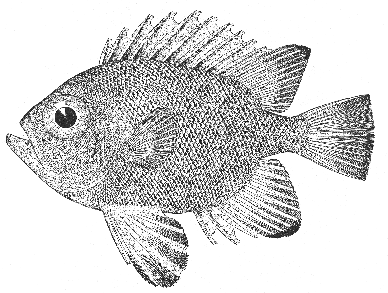Short big-eye Pseudopriacanthus altus (Gill) 1862
[Jordan and Evermann, 1896-1900, p. 1239.]

Figure 213.—Short big-eye (Pseudopriacanthus altus), Key West, Florida. From Jordan and Evermann. Drawing by H. L. Todd.
Description—
The most striking characters of this fish are its very large eyes and its brilliant red color. Apart from these, it is distinguishable from the sea bass tribe by the fact that its whole head, as well as its body, is clothed with rough scales and that the anal fin is longer than the soft-rayed portion of its dorsal fin. Its sidewise flattened body, unusually stout dorsal fin spines, very large ventral fins, and small pectorals, are ready field marks to separate it from the rosefish, the only common Gulf of Maine species of similar appearance that rivals it in color. The big-eye is ovate in outline, very thin through, with rounded dorsal profile, large head, notably oblique mouth, and enormous eyes. The spiny (10 spines) and soft (11 rays) portions of its dorsal fin are continuous, and extend back from the nape nearly to the base of the caudal fin. The anal (3 stout spines and 9 or 10 rays) originates under the eighth or ninth dorsal spine and its soft portion is nearly of the same form as the soft portion of the dorsal, except that its outer angle is somewhat more rounded. The caudal is square-cornered and slightly convex. The ventrals, which originate a little in front of the pectorals, are much larger than the latter, round tipped, and each commences with a stiff spine.
Color—
Bright red in life, below and above; dorsal fin red, the spinous, part edged with yellow, a few blackish dots on the soft rays; caudal fin pale, with blackish reticulations; anal red, edged with black; ventrals red at base, dusky on outer part; pectorals plain red. The iris is gold.
Size—
The largest specimen on record was 11 inches long.
General range—
Caribbean Sea, West Indies, and Gulf of Mexico in rather deep water, straying northward to the Woods Hole region and very rarely rounding Cape Cod.
Occurrence in the Gulf of Maine—
A big-eye found alive on Marblehead Beach, September 3, 1859; a second, found at Scituate, Mass., in 1932 or 1933;[43] and a third, about 1½ inches (38 mm.) long, picked up in a tide pool at Cohasset, Mass., by F. G. Bemis in September 1937,[44] are the only definite records for this southern fish within the Gulf. But since it occasionally appears in some numbers at Woods Hole in summer, it may round Cape Cod more often than this paucity of actual records suggests.